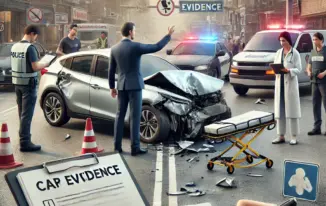A car accident can leave you shaken, disoriented, and unsure of what to do next. While it’s natural to feel overwhelmed, taking the right steps after an accident can help protect your well-being and ensure that you’re prepared for any legal or insurance matters that may follow.

Knowing what to do in the crucial moments following an accident can make all the difference. This step-by-step guide will walk you through the necessary actions to take and help you navigate the process with confidence.
1. Ensure Safety and Seek Medical Attention
The first thing you should do after a car accident is ensure that everyone involved is safe. Check yourself, your passengers, and others for injuries. If anyone is injured, it’s important to call emergency services right away. Even if there are no visible injuries, it’s wise to seek medical attention, as some injuries may not be immediately apparent.
Whiplash, concussions, and internal injuries can be hard to detect right after the accident, so always err on the side of caution and get checked by a healthcare professional. If the accident is minor and you can do so, move your vehicle to a safe location out of traffic to avoid further accidents.
2. Call the Authorities
No matter how minor the accident seems, it’s crucial to report the incident to the police. A police report is often required by insurance companies when processing claims, and it can serve as an official document that details the circumstances of the accident.
It’s also important for establishing fault in case of disputes. Be honest with the police, and make sure to provide accurate details of what happened. If the police do not come to the scene, gather as much information as possible, such as the names and badge numbers of officers and any case numbers.
3. Document the Scene
Once everyone is safe and emergency services have been contacted, take the time to document the scene. Use your phone or a camera to take clear photos of the damage to all vehicles involved, the surrounding area, any skid marks, and any injuries. Make sure to capture the location, road conditions, and any traffic signs or signals that could be relevant to the accident.
Also, write down the details of the accident, including the time, weather, and any contributing factors such as poor road conditions or visibility issues. Be sure to also collect the contact information of other drivers involved, including names, phone numbers, license plate numbers, and insurance details.
4. Consider Legal Assistance
If the accident resulted in significant injuries, complex circumstances, or disputes about who is at fault, consulting with a personal injury lawyer is a wise step. A lawyer can help you understand your rights and options, particularly when dealing with insurance companies or other parties involved in the accident. They can assist with gathering evidence, filing claims, and representing your interests in court if necessary.
Personal injury lawyers are well-versed in dealing with car accidents and can make sure that you receive the compensation you deserve for your injuries and damages. If you are unsure whether you need legal help, consider scheduling a consultation. Many personal injury lawyers offer free consultations, allowing you to discuss the specifics of your case without any obligation.
5. Notify Your Insurance Company
After the accident, you’ll need to notify your insurance company as soon as possible. Report the incident and provide them with all the necessary details, including the police report and any documentation you gathered from the scene. Be sure to answer their questions truthfully but avoid admitting fault or providing any speculative statements.
Insurance adjusters may ask for details, but you do not need to provide more information than what is necessary at this point. Let your insurance company investigate and determine liability. If your accident involves a significant amount of damage or injuries, you might consider seeking the guidance of a personal injury lawyer.
6. Follow Up with Medical Treatment
Even if you feel fine after the accident, it’s crucial to follow up with your doctor and continue any recommended medical treatment. Insurance companies may require proof of injuries to cover medical expenses, so keeping detailed records of all visits and treatments is important.
Continuing care also ensures that you address any potential long-term issues stemming from the accident, such as chronic pain or mobility limitations. Keep track of all medical bills, prescriptions, and any other related expenses. These records will be vital if you pursue a claim or need to prove the extent of your injuries to your insurance provider or a court.
7. Understand the Claims Process
The insurance claims process can be lengthy and complicated, but understanding what to expect can ease some of the stress. After reporting the accident, an insurance adjuster will typically review the damage, interview witnesses, and determine who is at fault.
If you are at fault, your insurance company will handle the claim on your behalf. If the other driver is at fault, you may need to work directly with their insurance company. If the insurance company’s settlement offer doesn’t fully cover your medical bills or vehicle repairs, you may need to negotiate or take legal action.
Conclusion
Accidents can be overwhelming, but taking the right steps can help you regain control and move forward. The aftermath of a car accident doesn’t have to be a stressful experience if you stay organized, and informed, and seek the right help when needed. Keep in mind that your health, safety, and well-being should always be your top priority. By handling the situation thoughtfully, you can navigate through the process with confidence and resilience, knowing you’re on the path to recovery.



